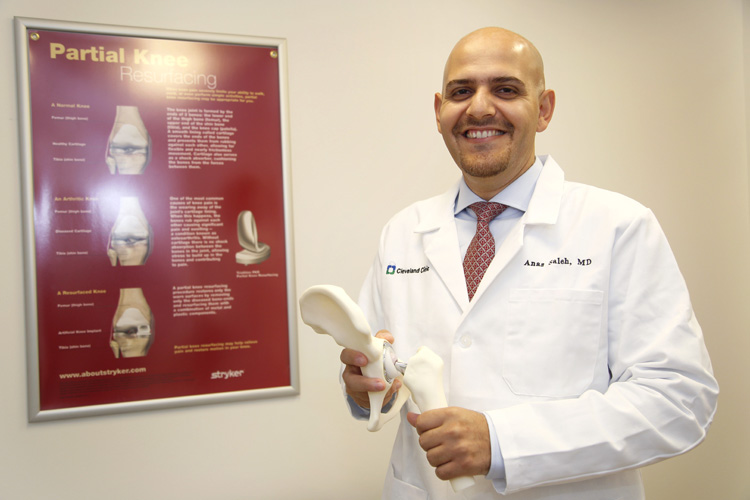
It takes a brave orthopedic surgeon to pick a topic like ‘the myths of arthroplasty surgery,’ but newly arrived Dr. Anas Saleh at Cleveland Clinic Indian River Hospital is eager to take that topic on.
Arthroplasty, or joint replacement surgery, according to Arthritis Health, “is performed most frequently on the hips and knees and involves the complete removal of the damaged joint and tissues to be replaced with an artificial prosthesis.
“The goal of the procedure is to relieve pain and restore a sense of normal function and mobility into the damaged joint. Joint replacement surgeries are recommended for patients experiencing severe pain and disability as a result of progressive arthritis.”
Myths – or, at the very least, misconceptions – about these joint replacement surgeries are as old as the procedures themselves and some, such as ‘you will lose your hair’ or ‘women will never be able to wear high heels again after undergoing a joint replacement,’ seem downright silly in 2020, but in Saleh’s eyes, far too many myths remain.
That’s odd, since “there are more than 1 million total joint replacements performed in the United States annually,” according to U.S. National Library of Medicine, which makes it seem people would be familiar with the facts about these procedures.
The same source has projected that number to increase four-fold by 2030 but that very projection, according to Saleh, may be the root cause of newer myths about arthroplasty procedures.
“A lot of these myths,” Saleh maintains, “actually stem from surgeons wanting to promote their own practices. Private groups, hospitals, whatever. They’re trying to promote their own practices,” and in the process they’re using certain catchwords or catch-phrases that may not be entirely accurate.
Catch-phrases like “minimally invasive.”
“Nobody,” Saleh contends, “has really defined what minimally invasive means. Patients in general don’t know what that means, or what’s considered minimally invasive – [or for that matter] what’s maximally invasive.”
He cites websites and even office visits where patients are asked specifically if they want a ‘minimally invasive’ joint replacement procedure, but he quickly adds, “I think it’s important for people to understand … there is really no such thing as a minimally invasive knee or hip replacement.”
Saleh continues, saying “a joint replacement procedure is a maximally invasive procedure.”
Think about that. Replacing your hip or knee may no longer require splaying those joints wide open, but it’s still serious surgery. And while the initial incision or incisions needed to reach the joint being replaced may be much smaller than they would have been decades ago, having a substantial piece of hardware fastened to bones inside your body seems to define ‘invasive.’
Part of the confusion arises because there are no set rules on what can be termed minimally invasive.
According to Saleh, “no one has defined” what constitutes minimal. Or, as he puts it, “are we [talking incisions that are] millimeters? Inches? How much is it, really?”
In any case, “there’s no scientific study in literature,” Saleh continues, “that shows any advantage to a minimally invasive approach over the standard approach.”
Even more to Saleh’s point, different patients have different problems that need to be addressed if different ways. So, a one-size-fits-all “minimally invasive” approach may not always be the best procedure for any given patient.
Another myth Saleh wants to bust is that any one of the three most used arthroplasty approaches has been proven any better than the other two.
Some orthopedic surgeons use only an anterior (from the front) approach while others like Saleh prefer a posterior (from the back) and still others choose a lateral (from the side) technique, but Saleh maintains the current literature does not support any one approach over the others.
“The reality,” according to Saleh, is “every approach has its own risk profile, and there is no one superior approach.” Though he does add, “Actually, the recent evidence is showing that the posterior approach has lesser complication than the anterior one,” but he refused to say it’s better.
“It’s not that it works better. I’m not saying that posterior is better. I think it’s better in the right hands. If your surgeon does posterior, you don’t want him to try and do an anterior because he’s not trained in it. His or her entire team is trained in it. It’s the same with the anterior surgeon. You don’t want him to do a posterior [or lateral] approach. It’s whatever the surgeon is confident with,” that the patient should opt for.
Saleh does recommend prospective patients meet with their orthopedic surgeon ahead of time to decide for themselves if what he or she is recommending is the right procedure for their specific problem.
Dr. Anas Saleh is an adult reconstruction and orthopedic surgeon with the Cleveland Clinic Indian River Hospital in Vero Beach. His office is in the hospital’s Health & Wellness Building at 3450 11th Court, Suite 302 in Vero Beach. The phone number is 772-794-1444.



